Komentáře / Otázky (7)
![]() Kari napsala:
Kari napsala:
Hei igjen:-) Tusen takk for at du ramset opp oppskriften, da skjønte jeg det, hurra! Beklager alle spørsmålene! Mvh Kari
24.02.2022 - 11:13
![]() Kari napsala:
Kari napsala:
Hei igjen! Tusen takk for svar. Ser at det stemmer at 2,5 er pinnestørrelsen. Har økt på begge sider i første farge i første rad med staver slik det står i oppskriften. Har heklet veldig stramt siden den ble så stor da jeg heklet løst, kanskje det er derfor den har blitt så rar:-) Får teste en gang til, hvis den har blitt sånn som på bildet når dere testet den ut så må det jo stemme i oppskriften. Mvh Kari
24.02.2022 - 07:27
![]() Kari Sletteberg napsala:
Kari Sletteberg napsala:
Svar til deres svar: Det er det jeg har gjort, men det blir absolutt ikke pent, kan problemet være at det er for få masker i første farge i utgangspunktet? Det resulterer i at økningen øverst blir en egen liten høyde som ikke blender med resten. Er det noe sted jeg kan sende bilder? Har dere testet ut denne oppskriften? Mvh Kari
14.02.2022 - 10:09Odpověď DROPS Design :
Hei Kari. I ditt 1.innlegg skriver du at økningene ikke skjer før i farge 2. Nei, det skjer i 1.rad med staver, altså med 1. farge. Men så skriver du i ditt 3. innlegg at du øker i 1. rad. Hva er riktig, når øker du? Du skriver også i ditt 1. innlegg at det er oppgitt heklenål 3, i oppskriften er det kun oppgitt 2,5 mm. Av de 2 andre Spørsmålene er det ingen som oppgir feil heklenår str. Stemmer heklefastheten din? Hekler du på begge sidene av luftmaskeraden og øker kun i den ene siden? Vi har heklet bikinien + 2 tester for å dobbeltsjekke nå, våre stemmer. Dessverre ingen mulighet å sende bilder, men ta kontakt med din butikk og la de se på arbeidet ditt.
21.02.2022 - 07:22
![]() Kari Sletteberg napsala:
Kari Sletteberg napsala:
Glemte å skrive spørsmålet: Hadde det ikke vært mest naturlig å øke stavmaskene etter rekken med luftmasker sånn at ikke arbeidet trekker seg sammen, eller har jeg forstått oppskriften feil og i tilfelle hva gjør jeg feil?
09.02.2022 - 13:50Odpověď DROPS Design :
Hei Kari. Se vårt svar på ditt første innlegg :) mvh DROPS Design
14.02.2022 - 08:56
![]() Kari Sletteberg napsala:
Kari Sletteberg napsala:
Bikinien har bare 21 masker i første farge og hekles på hver side. Økning skjer ikke før i farge 2. Da blir det så mange masker at den innerste delen som er mye kortere trekker arbeidet sammen. I tillegg var det oppgitt pinne 3, men måtte bruke 2,5 som oppgitt i kommentaren til en bruker under oppskriften. Kan sende bilder hvis jeg får en e-postadresse av dere. Mvh Kari
08.02.2022 - 10:48Odpověď DROPS Design :
Hei Kari. Jo, du øker i "toppen" på hver rad. Du hekler 1 stav i hver stav på hver side av luftmaske-raden og hekler 2 staver, 1 luftmaske 2 staver om luftmasken på toppen på hver rad. Så på neste rad hekler du også 2 staver, 1 luftmaske 2 staver i luftmasken fra forrige rad (=øker). Da får du en fin bue på "toppen". mvh DROPS Design
14.02.2022 - 08:53
![]() Maurine napsala:
Maurine napsala:
Bonjour, Pour la taille, il faut choisir en fonction du bonnet ? S = A, M = B, etc ? Merci.
18.04.2021 - 14:52Odpověď DROPS Design :
Bonjour Maurine, regardez le schéma des mesures, il pourra fort probablement vous orienter. Bon crochet!
19.04.2021 - 08:28
![]() Heidi Cecilie Brandshaug Løken napsala:
Heidi Cecilie Brandshaug Løken napsala:
Hekler str M. Cupen blir 20 cm bred nederst. Hva gjør jeg feil? Den er jo så lang og smal på bildet.
22.07.2017 - 11:25Odpověď DROPS Design :
Hej Heidi, hækler du i DROPS Safran, så hækler du lidt løsere end hvad vi gør ifølge opskriften. Om du gør det så vælg en nål som er et halvt nummer mindre, da kommer det sikkert til at stemme. God fornøjelse!
09.08.2017 - 15:19
Samantha#samanthabikini |
|
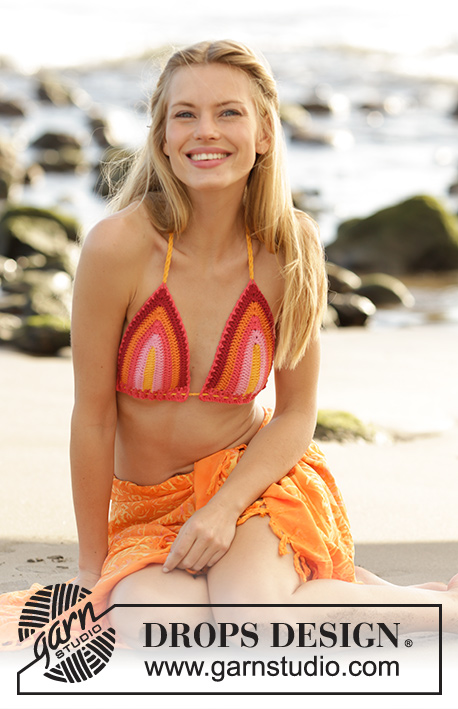 |
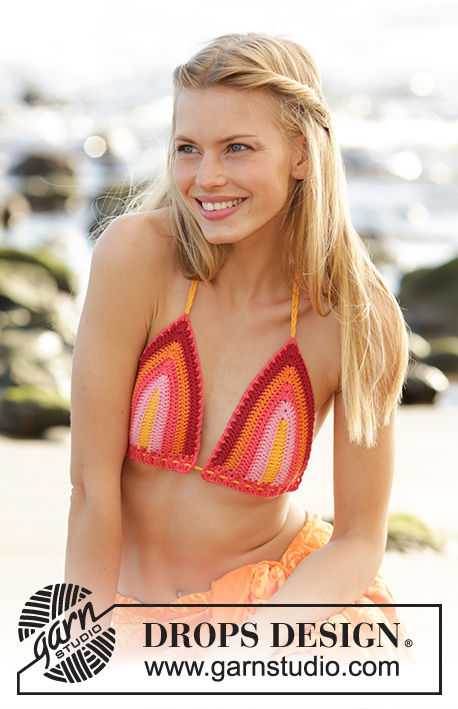 |
Pruhovaná bikiny podprsenka - top háčkovaná z příze DROPS Safran. Velikost XS - XXXL.
DROPS 178-73 |
|
|
INFO: V počáteční, první řadě uháčkujeme 1. dlouhý sloupek do 5. řetízkového oka od háčku (= 2 dlouhé sloupky). První dlouhý sloupek na začátku každé řady dlouhých sloupků nahrazujeme 3 řetízkovými oky. SLED PRUHŮ: POZN.: sled pruhů se liší podle velikostí. (Vyfocený model je velikost XS). Podívejte se na návrhy barevných kombinací pro jednotlivé velikosti. ZAČÁTEK + 1. ŘADA: žlutá. 2.-3. ŘADA: růžová. 4.-5. ŘADA: korálová. 6.-7. ŘADA: oranžová. Pro jednotlivé velikosti pokračujeme takto: VELIKOST XS: 8.-9. ŘADA: vínová. VELIKOST S: 8.-9. ŘADA: korálová. 10.-11. ŘADA: vínová. VELIKOST M: 8.-9. ŘADA: korálová. 10. ŘADA: oranžová. 11.-12. ŘADA: vínová. VELIKOST L: 8.-9. ŘADA: korálová. 10.-11. ŘADA: oranžová. 12.-13. ŘADA: vínová. VELIKOST XL a XXL: 8.-9. ŘADA: korálová. 10.-11. ŘADA: oranžová. 12. ŘADA: korálová. 13.-14. ŘADA: vínová. VELIKOST XXXL: 8.-9. ŘADA: korálová. 10.-11. ŘADA: oranžová. 12.-13. ŘADA: korálová. 14.-15. ŘADA: vínová. ---------------------------------------------------------- BIKINY - PODPRSENKA: Nejprve uháčkujeme 2 volné košíčky. Pak je spojíme kroucenou šňůrkou. KOŠÍČEK: Háčkem č.2,5 uháčkujeme žlutou přízí 21-21-24-27-27-32-38 řetízkových ok – viz SLED PRUHŮ! Pleteme v řadách, takto (1. řada = lícová): 1 dlouhý sloupek do 5. řetízkového oka od háčku (= 2 dlouhé sloupky) – viz INFO, po 1 dlouhém sloupku do každého z následujících 15-15-18-21-21-26-32 řetízkových ok, pak uháčkujeme (2 dlouhé sloupky, 1 řetízkové oko, 2 dlouhé sloupky) do posledního řetízkového oka v řadě, díl pootočíme, přeskočíme poslední řetízkové oko (tj. to řetízkové oko, které jsme právě uháčkovali) a do každého ze zbývajících 17-17-20-23-23-28-34 řetízkových ok na druhé straně řetízku uháčkujeme po 1 dlouhém sloupku = 38-38-44-50-50-60-72 dlouhých sloupků + 1 řetízkové oko. Práci otočíme a pokračujeme v řadách 1 dlouhým sloupkem do každého dlouhého sloupku na obou stranách řetízku, kolem řetízkového oka na vrcholku každé řady háčkujeme (2 dlouhé sloupky, 1 řetízkové oko, 2 dlouhé sloupky). Takto pokračujeme až do chvíle, kdy máme uháčkovaných celkem 9-11-12-13-14-14-15 řad dlouhých sloupků, jen v poslední řadě upravíme počet ok tak, abychom na každé straně řetízku měli 35-39-44-49-51-56-64 dlouhých sloupků (= celkem 70-78-88-98-102-112-128 dlouhých sloupků). Díl měří asi 11-14-15-16-18-18-19 cm – měřeno podél dolního okraje košíčku. Přízi odstřihneme. DOLNÍ OKRAJ KOŠÍČKU: Podél dolního okraje košíčku uháčkujeme korálovou přízí v řadách lem. 1. řadu háčkujeme kolem boku vnějšího (krajního) dlouhého sloupku, takto: 1. ŘADA: pomocí 1 krátkého sloupku napojíme přízi, uháčkujeme 3 řetízková oka (= 1 dlouhý sloupek), pak ještě 1 dlouhý sloupek kolem téhož dlouhého sloupku, potom háčkujeme *1 řetízkové oko, 2 dlouhé sloupky kolem následujícího dlouhého sloupku*, *-* opakujeme ještě 16-20-22-24-26-26-28x podél dolního okraje košíčku. 2. ŘADA: 3 řetízková oka (= 1 dlouhý sloupek), *1 řetízkové oko, 2 dlouhé sloupky vynecháme, 2 dlouhé sloupky kolem následujícího řetízkového oka*, *-* opakujeme ještě 16-20-22-24-26-26-28x, pak uháčkujeme 1 řetízkové oko a končíme 1 dlouhým sloupkem do posledního oka. 3. ŘADA: 3 řetízková oka (= 1 dlouhý sloupek), pak *1 řetízkové oko, 2 dlouhé sloupky kolem dalšího řetízkového oka*, *-* opakujeme ještě 17-21-23-25-27-27-29x. Přízi nestříháme! LEM: Háčkujeme *2 řetízková oka, 1 krátký sloupek*, *-* opakujeme 2x podél strany dolního lemu košíčku, pak *2 řetízková oka, 1 dlouhý sloupek vynecháme, 1 krátký sloupek do následujícího dlouhého sloupku*, *-* opakujeme až nahoru k řetízkovému oku na vrcholku košíčku, kolem tohoto řetízkového oka uháčkujeme (1 krátký sloupek, 2 řetízková oka, 1 krátký sloupek) a pokračujeme dolů podél druhé strany stejným způsobem. Končíme 1 krátkým sloupkem kolem posledního dlouhého sloupku v poslední řadě dolního lemu košíčku. Přízi odstřihneme a zapošijeme. Stejným způsobem uháčkujeme ještě druhý košíček. VÁZAČKA – KROUCENÁ ŠŇŮRKA: Ustřihneme si 3 vlákna žluté příze, každé o délce 3 metry. Vlákna stáčíme pevně dohromady - jakmile se začnou samovolně kroutit, přeložíme je napolovic a necháme zkroutit znovu. Na každém konci uvážeme uzel a konce zastřihneme. Šňůru pak protáhneme mezi skupinkami dlouhých sloupků v dolním lemu obou košíčků. Podprsenku zavazujeme na zádech. Ustřihneme si 3 vlákna žluté příze, každé o délce 1,2 metru. Vlákna stáčíme pevně dohromady - jakmile se začnou samovolně kroutit, přeložíme je napolovic a necháme zkroutit znovu. Na každém konci uvážeme uzel a konce zastřihneme. Šňůru pak protáhneme vrcholkem jednoho košíčku a svážeme větším uzlem. Stejným způsobem vyrobíme druhou vázačku a připevníme ji ke druhému košíčku – zavazujeme za krkem. |
|
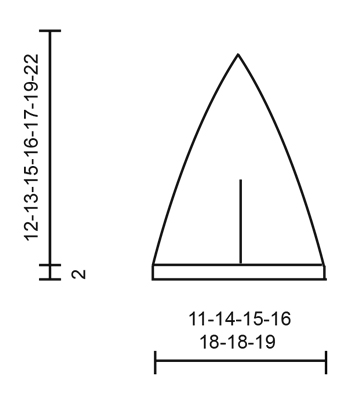
|
|
Dokončili jste tento model?Pak označte své fotky tagem #dropspattern #samanthabikini nebo je pošlete do galerie #dropsfan. Potřebujete s tímto návodem poradit?Otevřete-li si návod na stránce garnstudio.com, najdete tam 7 výukových video-ukázek, Komentáře/Dotazy a další užitečné informace. © 1982-2025 DROPS Design A/S. Vyhrazujeme si veškerá práva. Tento dokument, včetně všech jeho dílčích částí, podléhá autorským právům. Podrobnější komentář k možnostem užití našich návodů najdete dole pod každým návodem na našich stránkách. |
|








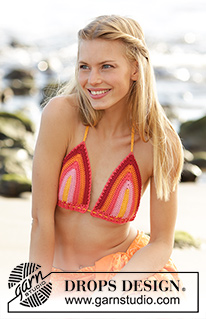




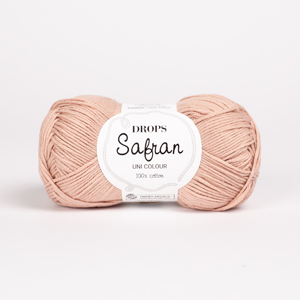
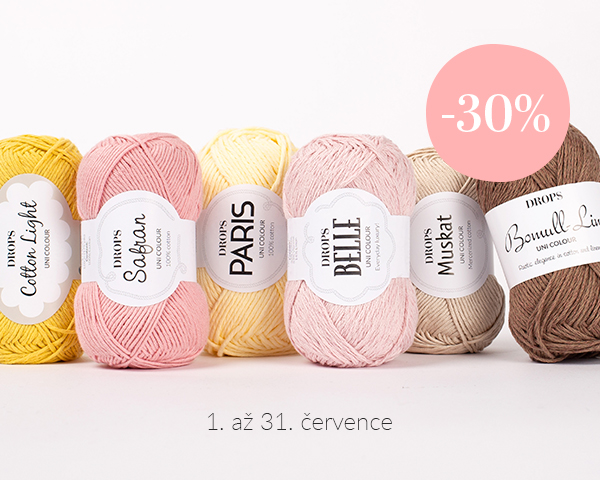
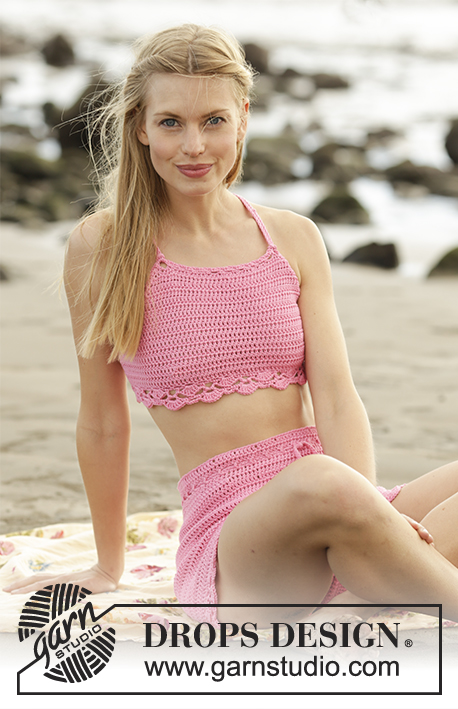
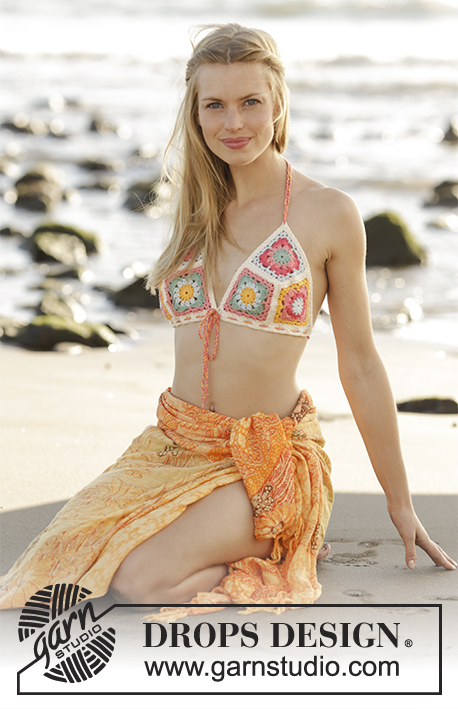
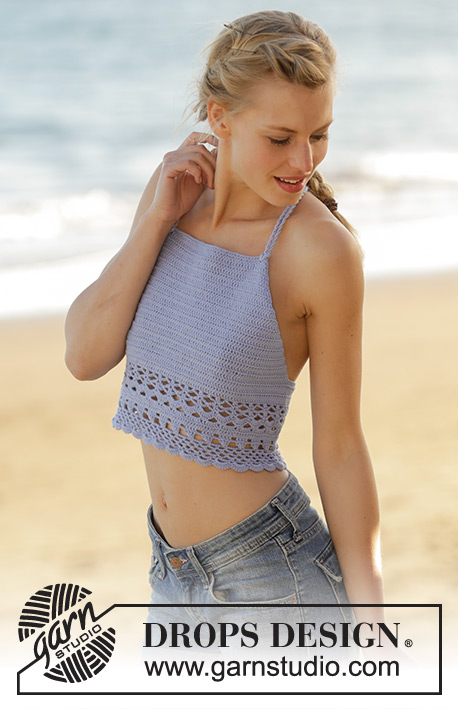














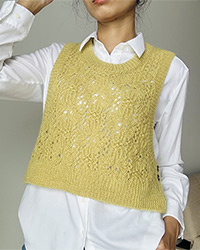

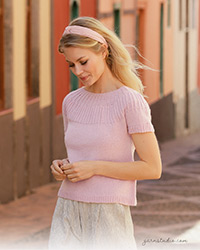
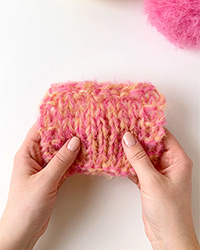
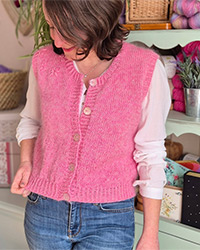
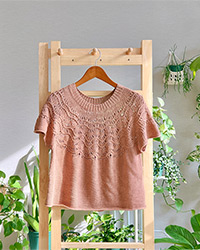
Přidejte komentář k návodu DROPS 178-73
Rádi bychom věděli, co si o tomto modelu myslíte!
Pokud se chcete na něco zeptat, dbejte prosím na to, abyste ve formuláři níže vybrali správnou kategorii - díky tomu se dříve dozvíte, co potřebujete vědět. Povinná pole jsou označena *.